The UIAA held its first Climate Change Summit during its General Assembly in Banff, Canada at the end of October.
The aim of the Summit was to provide an opportunity to discuss topics related to sustainability and climate change, the role of the recently created UIAA Climate Change Taskforce, and to learn and to better understand needs and expectations of member federations.
On the occasion of International Mountain Day (IMD) 2022, the UIAA is sharing the results and findings of the Summit. Please also find a number of other UIAA releases published for IMD including confirmation that the federation is updating its Environmental Objectives and Guidelines and its role in the United Nations Framework Convention on Climate Change (UNFCCC) Sports for Climate Action (S4CA) Framework
HEADLINE CONCLUSIONS
- Climate action is a high priority for mountaineering federations and for mountaineers, as impacts are undeniable.
- The mountaineering world must adapt to climate change (climbing techniques, equipment development, where/when to travel, route choice and access) and mitigate its impact where possible (avoid, reduce and compensate carbon footprint).
- Only a handful of UIAA member federations currently calculate their greenhouse gas (GHG) emissions footprint.
- Resources of UIAA and member federations (people, time, money, expertise) varies and must be considered when making recommendations on climate action.
- Travel/mobility is the main contributor of a mountaineer’s (whether individual, as a section, national or international organisation) footprint.
- The UIAA, through its new Taskforce, should lead the way in climate action, and offer its members a platform to share and exchange best practices.
TABLE DISCUSSIONS
The results were the fruit of several table discussions focussing on different topics. Below are some of the key highlights which offer greater context to the headline conclusions drawn above:
Climate Change Adaptation vs. Mitigation
- There is no more debate that climate change is happening. Adaptation means we have to change our behaviour to adapt, whereas mitigation refers to actions to slow down climate change.
- Terminology, and thinking, may need to change from climate change ‘adaptation’ to ‘transformation’, as a concept that impresses a need to move away from “business as usual”.
- The biggest issue in practicing mountaineering activities is travel – especially flights (see below).
- There needs to be some way of making it easy – perhaps standardising – a way of calculating the carbon footprint for mountaineering and climbing activities. Tools and scope are not clear, own definitions on scope and definitions are not universally standard. The UIAA should offer a common and easy calculation tool.
- Greater consideration should be given for carbon “budgeting” for mountaineering travel – especially air travel (e.g. reducing other air travel throughout the year to allow mountaineering air travel in your carbon air travel “budget”).
- The opportunity for bigger, more resource rich UIAA federation members to help smaller federations with climate change adaptation, transformation, and mitigation. In many cases expertise, people, and time will be more important than money.

Mitigation & Climate Action Plan – Roles of UIAA and of Member Federations
- On mitigation, the UIAA should prioritise and compensate for the emissions of inevitable air travel and needs to find the funding and provider for reliable and credible carbon credits for UIAA events and travel.
- In future the UIAA should consider only hosting meetings with a hybrid option for online participants. The hosts need to be able to provide reliable connectivity and digital infrastructure. There is a need to make this part of the hosting guidelines for UIAA events. If federations bid to host a meeting, they need to have this provision in place.
- Promote less visited areas and regions, but facilitate access to pooled travel options for transfers (e.g. buses, vans, or shared car travel). The UIAA needs to provide this option as part of the delegate registration process to events such as the General Assembly or Executive Board/Management Committee meetings.
- A key challenge is that, at the end of the day, climbers and mountaineers rely on the consumption of natural resources for their activities, so the focus should be on how to reduce the level of consumption.
- In the long run, measures that are introduced to reduce emissions or resources used (e.g. plastics) need to be transformative i.e. be a step change from the usual practice, and not incremental.
- Mountaineers should not forget how climate change is affecting local people. Often, we, as climbers get caught up in seeing streams dry up, witnessing landslides, glaciers melting etc. and forget what this means for mountain people.
Mitigation & Climate Action Plan – Climbers’ Travel
How can travel be avoided and/or reduced in a climber’s role as (a) a mountaineer; (b) an event organiser; (c) a federation delegate; (d) an athlete?
Living location
- Choosing an area to live near to where you want to climb or hike was seen as important, especially now with remote working options more readily available.
- Choosing a green city with good infrastructure. Some cities are easier for this than others having “greener” policies on how it is possible to move around and out of the city.
Local travel
- Choose your mode of transport to local wall or crag if possible, traveling by foot, bike, e-bike as a preference or use public transport such as train or carpooling. Availability of an electric car/bus option.
- Some national parks provide bus services, even electric buses between the city and the climbing/mountaineering location. In some mountain regions there is no choice but to use this transport for going into protected areas. However, it was noted in some countries or areas there are a limited range of options are available, so climbers are reliant on the existing infrastructure unless in a position to plan hut or climbing wall locations for example.
- Staying local where possible was considered good but in some locations, it just isn’t possible to climb without going further afield.
- Pooling travel using social media. Making use of social media for pooling travel arrangements was actively used and as well as ride share, hut systems and reducing travel itself.
Travel – Bigger Picture
- Travel is the single largest contributor to the overall emissions for most outdoor trips.
- For most countries, there aren’t different domestic transport options available. Parts of Europe have trains vs. cars but most of world doesn’t have that option.
- Instead of flying into remote huts or climbs choose to walk in and out. Make the walk-in and out part of the overall experience, often results in a richer overall experience.
- “Staying Local” is commonly raised. But when examined this is a privileged statement. Geographically – easy to say “stay local” if living a mountain place like Banff or the European Alps but not easy for a keen climber living on the Canadian prairies. Demographically – easy to say by an older person who has already experienced travelling widely but not easy or equitable to ask a younger climber to do the same.
- International travel usually requires flying. Overland travel isn’t an option from most countries.
- Reduced international travel is needed but this will actually economically harm mountain regions who rely on international climbers and trekkers. Supporting mountain workers, local communities and the trekking industry is important.
- Consider ‘quality over quantity’. Instead of say, three international trips a year, choose to make only one longer one.
- Offsetting and compensation of emissions from flying or driving is fine but be careful of greenwashing by the airline. Understand that compensation is ultimately a “cop out” by the individual as it doesn’t require any behaviour change, only a financial contribution.
- Some conferences are now running an optimisation to select a meeting location with the least total emissions, including attendees travel.
- Regional competitions can be more efficient than “global” if itinerary is planned properly.

Mitigation & Climate Action Plan – Construction & Operation of Mountain Huts
During this topic participants assessed the main case of CO2 emissions of a mountain hut:
- Access to the parking of the huts: As for ski resorts, the biggest impact on the carbon footprint is users’ mobility. So, we could expect the same in huts as there is barely any public transportation to access the start of the hut trail access.
- Building and renovations of the huts: materials, supply by air, and building are considerable contributors to huts’ footprint.
- Catering: especially for day guests.
- Heating: Burning wood.
- Energy supply: huts don’t rely only on renewables. They have a significant variation in the hut occupancy throughout the day, the week, and the season. Therefore, a generator is often used which is detrimental to the huts’ footprint.
- Supply (helicopter, cable car, car). For some isolated huts, it can be one of the biggest sources of emission.
- Waste (incineration): Waste has to be taken down by air or sometimes it is incinerated on site.
- Humane waste (dry toilet problems): Even though dry toilet has a better impact on the environment, in high-altitude huts, they may be heated (so human waste can reduce gradually), and/or at the end, the human waste is taken down by helicopter.
Participants then assessed possible solutions to reduce impact in huts:
- Extreme: Not going to the hut. It would be very efficient but not durable for mountaineering activities.
- Unmanned hut: this could avoid all the problems with the supply and catering of huts. They would be much more autonomous.
- Self-sufficient: You could still have a hut keeper, but people will bring all the supplies needed (food and so on).
- Pay more: People would think twice about their impact. They’d be fewer people going up. On the other hand, the UIAA also stands for greater, and free, access to the mountains.
The Climate Change Summit also featured two fascinating case studies, one from François Masse, Parks Canada, who spoke about the Abbot Pass Hut, the first climbing infrastructure in Canada lost to climate change. Dr Graham McDowell, University of Calgary, then addressed the topic of the impact of warmer winters on ice climbing guides.
A summary of both presentations will be published on the UIAA website in due course.



